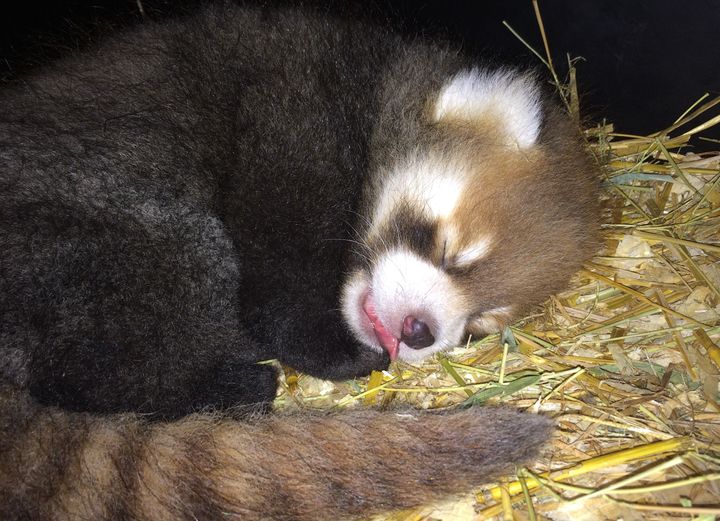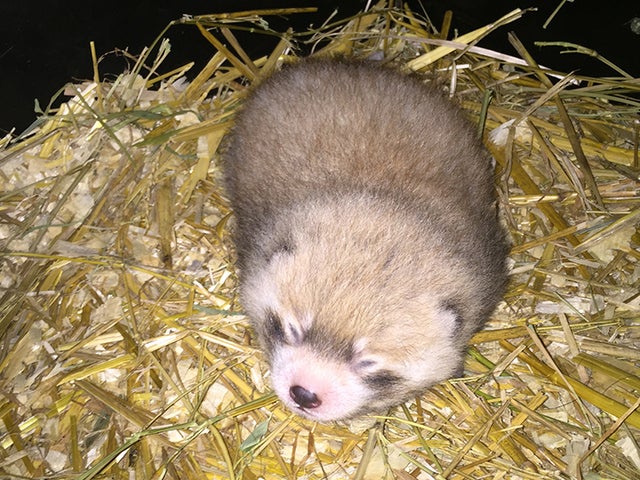The Cincinnati Zoo & Botanical Garden’s red panda care team was not surprised when a red panda cub was born on June 25, 2017. Thanks to a multi-year research study by the Zoo’s Center for Conservation and Research of Endangered Wildlife (CREW), the caregivers knew that mom, Lin, was pregnant, and so they were able to prepare for the impending birth of this endangered species.

Red panda baby, born June 25, 2017, sleeping in nest box.
Red pandas are one of many cold-weather animals that experience delayed implantation during pregnancy, in which an embryo stops growing and can float around for weeks or months before attaching to the uterine wall. This results in a two-month window of potential due dates for all expecting moms. Additionally, non-pregnant females can experience pseudo-pregnancies: following breeding season, they may gain weight and build nests, even though no embryos are present. Together, these two reproductive phenomena make it nearly impossible to diagnose pregnancy or predict parturition date in this species.
From 2012-2015, CREW’s Dr. Erin Curry analyzed fecal samples and performed ultrasounds on the Zoo’s potentially pregnant females. The data she collected has helped her accurately predict the birth dates of several red panda cubs. Knowing that a female is pregnant and having a realistic birth date is an enormous help to the people who manage these animals, so the red panda care team showed their appreciation for Dr. Curry’s work by naming a cub born two years ago “Dr. Erin Curry“.
Cincinnati Zoo staff used operant conditioning to train its female red pandas to participate in ultrasound exams. “They love grapes, so we were able to teach the desired standing behavior using those and other favorite foods as motivation,” said senior Wildlife Canyon keeper Lissa Browning.
Dr. Erin Curry explains that training these animals to voluntarily stand for ultrasound exams is not an easy feat and credits the Wildlife Canyon team for helping multiple red pandas master the behavior that made this important study possible. “The females stand still for several minutes for the exam and even allow us to apply handfuls of ultrasound jelly to their abdomens, which is necessary for the ultrasound waves to penetrate their thick fur,” said Curry.
“We’re trying to develop a model that other Zoos can use to identify if and when their animals might give birth,” Curry said. Results of this 4-year study have been published in the scientific journal Zoo Biology . Being able to accurately diagnose pregnancy in species like red pandas, polar bears, otters, and wolverines will facilitate improved husbandry and allow caretakers to better prepare for the arrival of cubs. The ultimate goal of Dr. Curry’s research is to develop a non-invasive pregnancy test, based on a fecal sample, which would alleviate the need for ultrasound training and so could be more easily applied to populations of animals in the wild.

Cincinnati Zoo leads the world in red panda births for the fulgen Styani subspecies, having produced a total of 86. Red pandas, found mostly in China and Nepal, are endangered due to habitat loss and poaching and their numbers are declining.
About the Study:
“Integrating trans-abdominal ultrasonography with fecal steroid metabolite monitoring to accurately diagnose pregnancy and predict the timing of parturition in the red panda (Ailurus fulgens styani)” research paper was authored by Dr. Erin Curry, Lissa J. Browning, Paul Reinhart, and Dr. Terri L. Roth. Project contributors include Cincinnati Zoo & Botanical Garden’s Wildlife Canyon keeper staff, including Libby Flaherty and Ashley O’Connell, for collecting samples and facilitating ultrasound examinations; Chase Bodkin for assisting with ultrasound examinations, and Patricia Hermes and the volunteers in CREW’s endocrine lab for their assistance with processing fecal samples.
About the Cincinnati Zoo:
The world famous Cincinnati Zoo & Botanical Garden is committed to inspiring visitors to care about wildlife and wild places. It has been rated the #1 attraction locally and one of the top zoos in the nation by Zagat Survey. It has also received rave reviews from Child Magazine, Parents Magazine, USA Today and TripAdvisor. Over 1.5 million people visit the Zoo’s award-winning exhibits, and more than 500 animal and 3000 plant species annually. The Zoo, an accredited member of the Association of Zoos & Aquariums (AZA), is internationally known for its success in the protection and propagation of endangered animals and plants and engages in research and conservation projects worldwide. Known as the #GreenestZooInAmerica, the Zoo is doing its part to conserve natural resources that are critical to saving wildlife and its habitats and is committed to greening its daily operations and reducing its impact on the environment through the use of rain gardens, recycled building materials, solar panels and more. The Cincinnati Zoo is a 501(c)(3) nonprofit organization.
